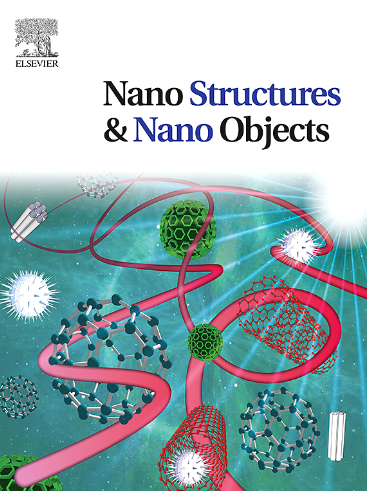Complete carbohydrate-based synthetic strategy for an efficient plasmonic metal and alloy nanostructured SERS substrate
IF 5.45
Q1 Physics and Astronomy
引用次数: 0
Abstract
Surface enhanced Raman spectroscopy (SERS) has grown to be one of the most effective spectroscopic methods with a wide range of applications since the discovery of enhanced spectrum of pyridine on a silver electrode. However, the challenges in fabricating an affordable, simple, and long-lasting substrate restricts its application in devices. In this study, we report for the first time on a novel, inexpensive polymer-based SERS substrate made by thermally evaporating colloidal solutions of metal and alloy nanoparticles over humid sheets of cellulose acetate (CA). Green synthetic strategies were adopted for preparing nanoparticles using glucose as the reducing agent and starch as the capping agent. Au, Ag and their alloys decorated CA sheets were prepared, and the nanoparticle formation is confirmed by UV-Visible absorption spectroscopy. Diffuse reflectance spectroscopy (DRS), scanning electron microscopy (SEM), energy dispersive X-ray spectroscopy (EDAX), atomic force microscopy (AFM) and Fourier transform infra-red (FT-IR) spectroscopy were used for the characterization of the nanoparticle decorated CA sheets. 1,4-benzenedithiol (1,4-BDT) is used as the Raman active molecule for SERS studies. A noticeably greater Raman enhancement was observed using these sheets, demonstrating the potential of these substrates for use in SERS-based devices.
高效等离子体金属和合金纳米结构SERS衬底的完整碳水化合物合成策略
自发现吡啶在银电极上的增强光谱以来,表面增强拉曼光谱(SERS)已成为最有效的光谱方法之一,具有广泛的应用前景。然而,制造价格合理,简单且持久的基板所面临的挑战限制了其在器件中的应用。在这项研究中,我们首次报道了一种新型的、廉价的聚合物基SERS衬底,该衬底是由金属和合金纳米颗粒的胶体溶液在潮湿的醋酸纤维素(CA)薄片上热蒸发制成的。采用绿色合成策略,以葡萄糖为还原剂,淀粉为封盖剂制备纳米颗粒。制备了Au、Ag及其合金修饰的CA片,并通过紫外-可见吸收光谱证实了纳米颗粒的形成。利用漫反射光谱(DRS)、扫描电子显微镜(SEM)、能量色散x射线光谱(EDAX)、原子力显微镜(AFM)和傅里叶变换红外光谱(FT-IR)对纳米粒子修饰的CA片进行了表征。1,4-苯二硫醇(1,4- bdt)作为拉曼活性分子用于SERS研究。使用这些薄片观察到明显更大的拉曼增强,证明了这些衬底用于基于sers的器件的潜力。
本文章由计算机程序翻译,如有差异,请以英文原文为准。
求助全文
约1分钟内获得全文
求助全文
来源期刊

Nano-Structures & Nano-Objects
Physics and Astronomy-Condensed Matter Physics
CiteScore
9.20
自引率
0.00%
发文量
60
审稿时长
22 days
期刊介绍:
Nano-Structures & Nano-Objects is a new journal devoted to all aspects of the synthesis and the properties of this new flourishing domain. The journal is devoted to novel architectures at the nano-level with an emphasis on new synthesis and characterization methods. The journal is focused on the objects rather than on their applications. However, the research for new applications of original nano-structures & nano-objects in various fields such as nano-electronics, energy conversion, catalysis, drug delivery and nano-medicine is also welcome. The scope of Nano-Structures & Nano-Objects involves: -Metal and alloy nanoparticles with complex nanostructures such as shape control, core-shell and dumbells -Oxide nanoparticles and nanostructures, with complex oxide/metal, oxide/surface and oxide /organic interfaces -Inorganic semi-conducting nanoparticles (quantum dots) with an emphasis on new phases, structures, shapes and complexity -Nanostructures involving molecular inorganic species such as nanoparticles of coordination compounds, molecular magnets, spin transition nanoparticles etc. or organic nano-objects, in particular for molecular electronics -Nanostructured materials such as nano-MOFs and nano-zeolites -Hetero-junctions between molecules and nano-objects, between different nano-objects & nanostructures or between nano-objects & nanostructures and surfaces -Methods of characterization specific of the nano size or adapted for the nano size such as X-ray and neutron scattering, light scattering, NMR, Raman, Plasmonics, near field microscopies, various TEM and SEM techniques, magnetic studies, etc .
 求助内容:
求助内容: 应助结果提醒方式:
应助结果提醒方式:


